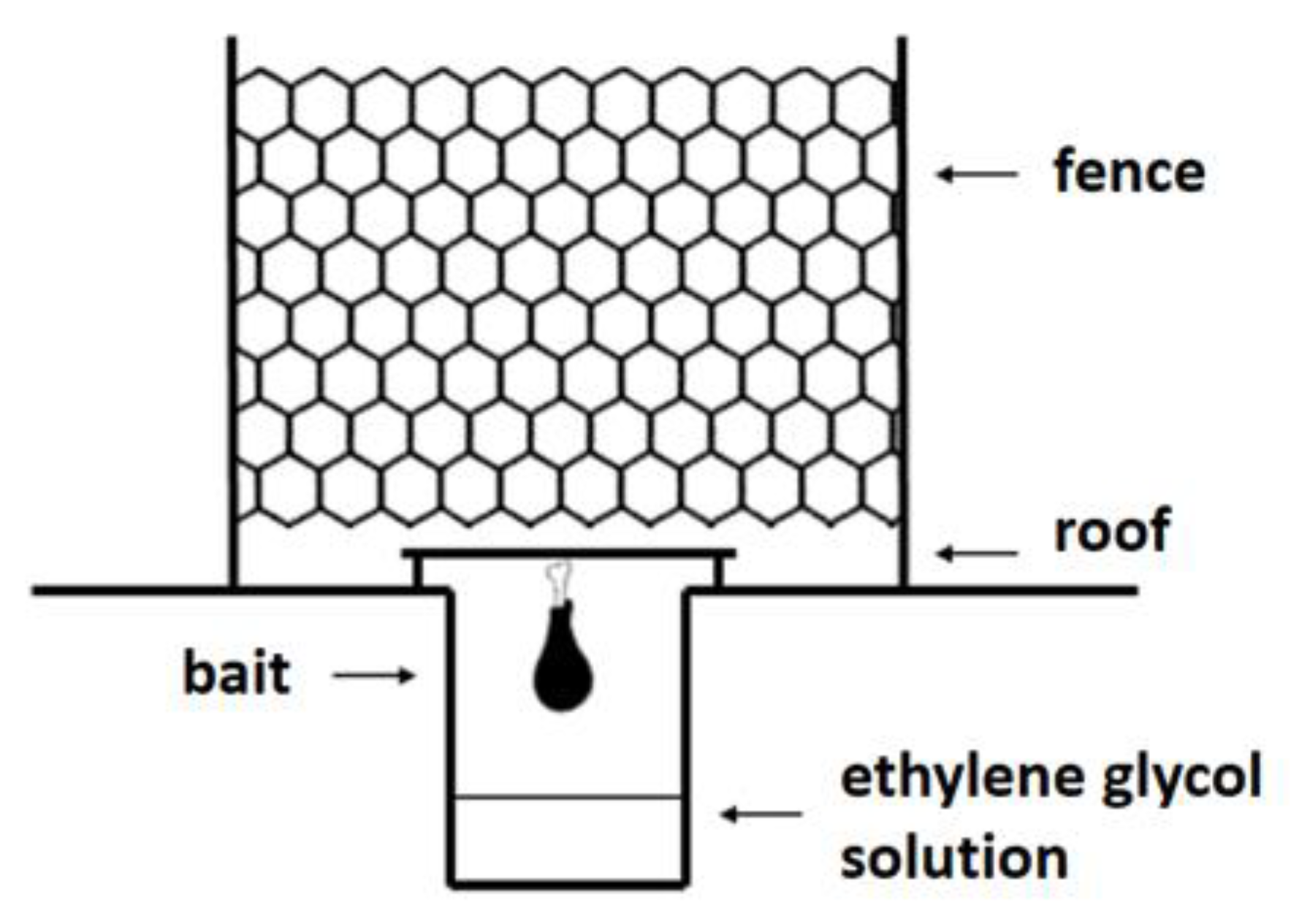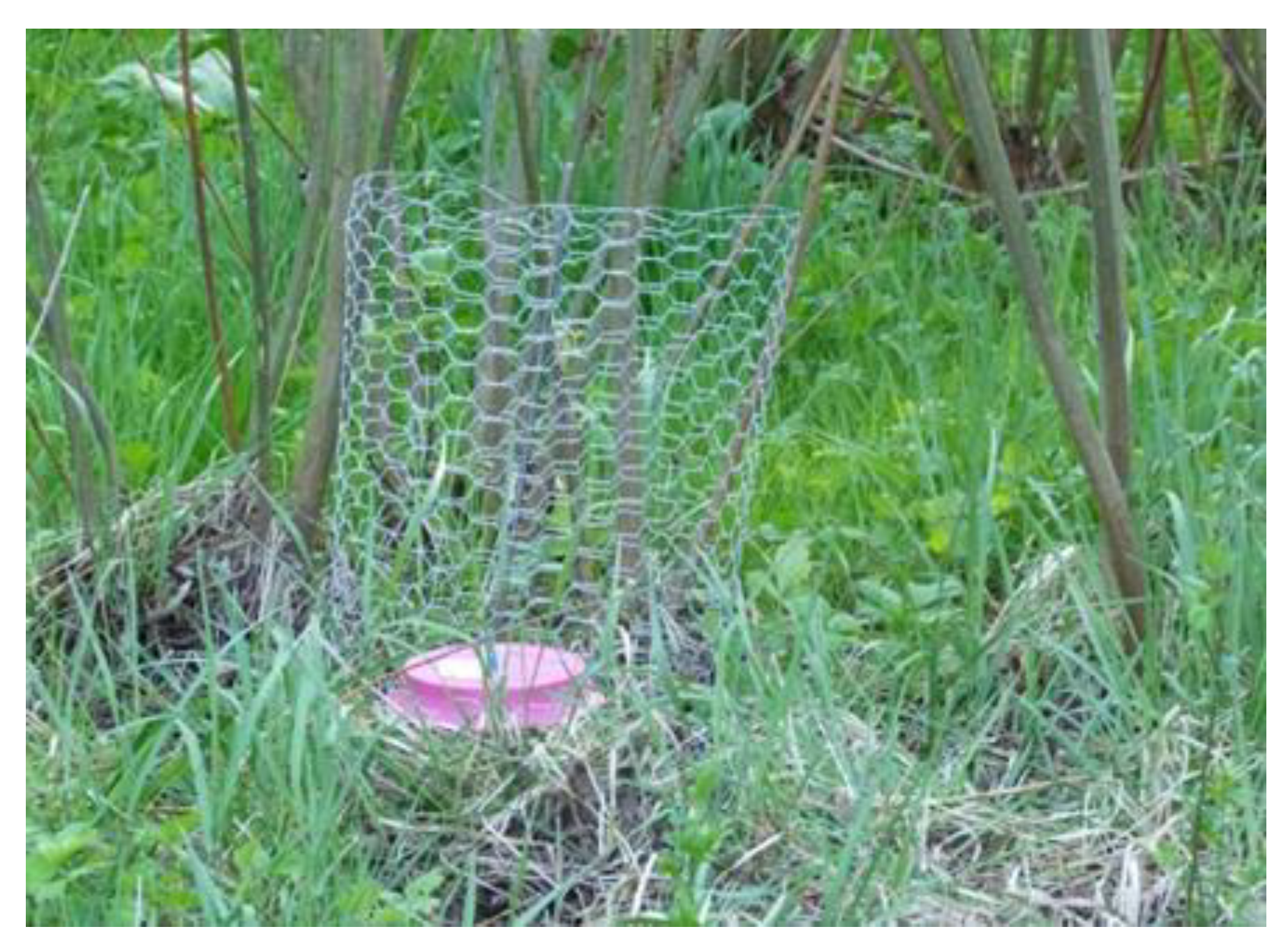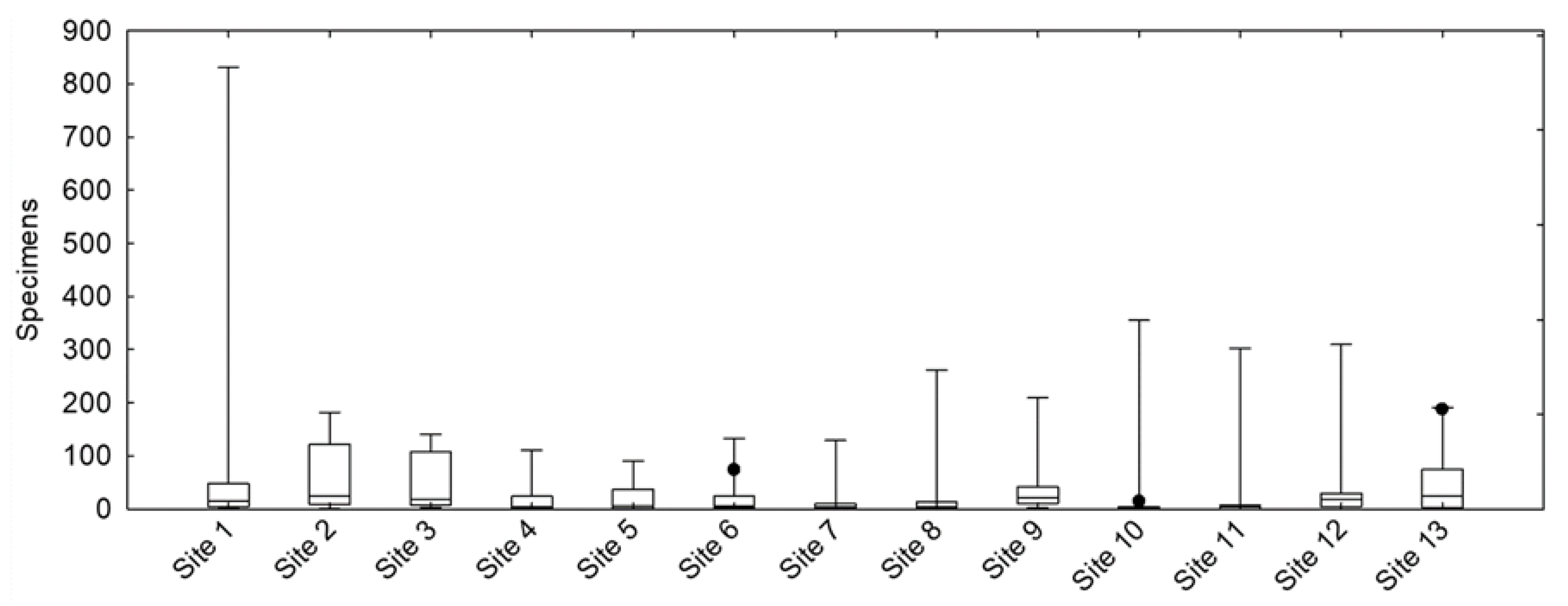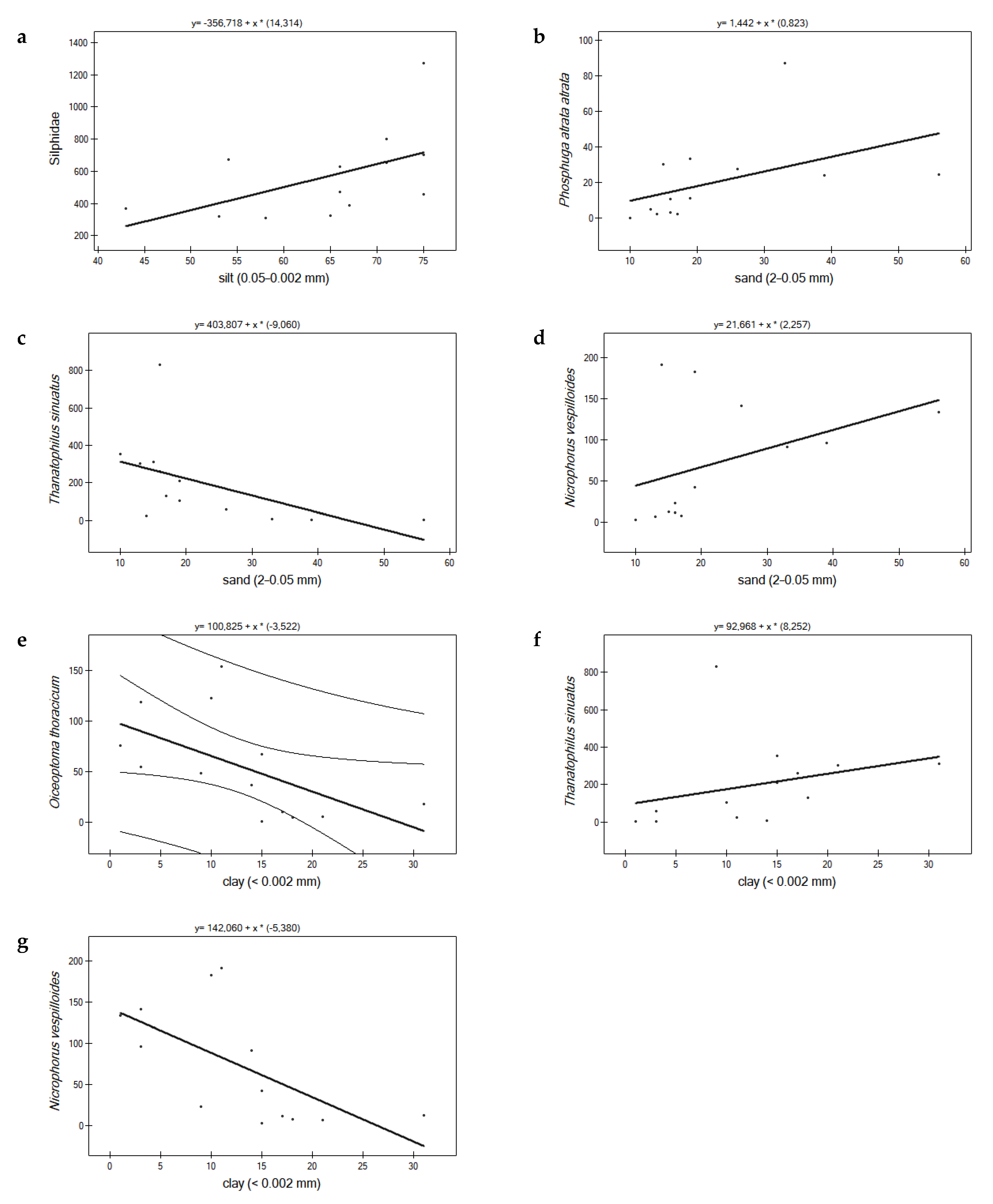Effect of Granulometric Composition of the Soil on the Occurrence of Carrion Beetles (Coleoptera: Silphidae)
Abstract
1. Introduction
2. Materials and Methods
2.1. Research Area
2.2. Analysis of Soil Granulometric Composition
2.3. Collection of Entomological Material
2.4. Nomenclature and Statistical Analysis
3. Results
3.1. Soil Granulometric Composition
3.2. Silphidae Species Composition
3.3. Influence of Soil Granulometric Composition on the Occurrence of Silphidae
4. Discussion
5. Conclusions
- Soil granulometric composition is an important parameter of the soils of the habitat and may determining their colonization by the carrion beetles (Coleoptera: Silphidae).
- A positive correlation and a statistically significant relationship were found between the total number of Silphidae and the share of the mechanical fraction of soil with a diameter of 0.05–0.002 mm (silt fraction).
- In the case of representatives of Nicrophorinae, the only species showing a statistically significant relationship between the abundance and the proportion of mechanical fractions was N. vespilloides.
- Among the representatives of Silphinae, a statistically significant relationship between the abundance and the content of soil mechanical fractions occurred in the case of O. thoracicum. P. atrata atrata, and T. sinuatus.
Supplementary Materials
Author Contributions
Funding
Institutional Review Board Statement
Informed Consent Statement
Data Availability Statement
Conflicts of Interest
References
- Anderson, S.; Peck, B. The Insects and Arachnids of Canada, Part 13: The Carrion Beetles of Canada and Alaska (Coleoptera: Silphidae and Agyrtidae); Agriculture Canada: Ottawa, ON, Canada, 1985; p. 121. ISBN 0-662-11752-5. [Google Scholar]
- Sikes, D. Silphidae Latreille, 1807. In Handbook of Zoology, Vol. IV: Arthropoda: Insecta, Part 38: Coleoptera, Beetles. Vol. 1: Morphology and Systematics (Archostemata, Adephaga, Myxophaga, Polyphaga); Beutel, R.G., Leschen, R.A.B., Eds.; Walter de Gruyter: Berlin, Germany, 2008; pp. 288–296. [Google Scholar]
- Sikes, D. Carrion Beetles (Coleoptera: Silphidae). In Encyclopedia of Entomology, 2nd ed.; Capinera, J.L., Ed.; Springer: Berlin, Germany, 2008; Volume 4, pp. 749–758. ISBN 978-1-4020-6242-1. [Google Scholar]
- Trumbo, S.T. Monogamy to communal breeding: Exploitation of a broad resource base by burying beetles (Nicrophorus). Ecol. Entomol. 1992, 17, 289–298. [Google Scholar] [CrossRef]
- Lomolino, M.V.; Creighton, J.C.; Schnell, G.D.; Certain, D.L. Ecology and conservation of the endangered American burying beetle (Nicrophorus americanus). Conserv. Biol. 1995, 9, 605–614. [Google Scholar] [CrossRef]
- Hatten, J.; Liles, G. Chapter 15: A ‘healthy’ balance: The role of physical and chemical properties in maintaining forest soil function in a changing world. In Global Change and Forest Soils: Cultivating Stewardship of a Finite Natural Resource; Busse, M., Page-Dumroese, D.S., Morris, D.M., Giardana, C.P., Eds.; Developments in Soil Science; Elsevier: Amsterdam, The Netherlands, 2015; Volume 36, pp. 373–396. [Google Scholar]
- Muths, E.L. Substrate discrimination in burying beetles, Nicrophorus orbicollis (Coleoptera: Silphidae). J. Kans. Entomol. Soc. 1991, 64, 447–450. [Google Scholar]
- Scott, M.P. The ecology and behavior of burying beetles. Annu. Rev. Entomol. 1998, 43, 595–618. [Google Scholar] [CrossRef]
- Creighton, J.C.; Vaughn, C.C.; Chapman, B.R. Habitat preference of the endangered American burying beetle (Nicrophorus americanus) in Oklahoma. Southw. Nat. 1993, 38, 275–277. [Google Scholar] [CrossRef]
- Otronen, M. The effects of body size on the outcome of fights in burying beetles (Nicrophorus). Ann. Zool. Fenn. 1988, 25, 191–201. [Google Scholar]
- Kevan, D.K.M. Soil Animals; Philosophical Library: New York, NY, USA, 1962; p. 237. [Google Scholar]
- Mocek, A.; Drzymała, S.; Maszner, P. Genesis, Analysis and Classification of Soils; Agric. Univ. Press: Poznań, Poland, 2000; p. 416. (In Polish) [Google Scholar]
- Lovelland, P.J.; Whalley, W.R. Particle size analysis. In Soil and Environmental Analysis Physical Method; Smith, K.A., Mullins, C.E., Eds.; Dekker Press: New York, NY, USA, 2001; pp. 271–328. [Google Scholar]
- Ditzler, C.; Scheffe, K.; Monger, H.C. Soil Science Division Staff. Soil Survey Manual. USDA Handbook 18; Government Printing Office: Washington, DC, USA, 2017; p. 603. [Google Scholar]
- Löbl, L.; Löbl, D. Catalouge of Palearctic Coleoptera. Hydrophiloidea-Staphylinoidea; Revised and Updated ed.; Brill: Leiden, The Netherlands, 2015; Volume 2, p. 1702. ISBN 978-90-04-28992-5. [Google Scholar]
- Mroczkowski, M. Part XIX. Beetles-Coleoptera. Carrion Beetles-Silphidae. Keys to the Identification of Polish Insects; Państwowe Wydawnictvo Naukowe: Warszawa, Poland, 1955; Volume 4, p. 29. (In Polish) [Google Scholar]
- Šustek, Z. Czechoslovak carrion beetles (Coleoptera, Silphidae). Reports of the Czechoslovak Entomological Society ACCA. Klíče k určování hmyzu 1981, 2, 1–47. (In Czech) [Google Scholar]
- Hammer, Ø.; Harper, D.A.T.; Ryan, P.D. PAST: Paleontological statistics software package for education and data analysis. Palaeontol. Electron. 2001, 4, 1–9. [Google Scholar]
- Górny, M.; Grüm, L. Methods Using in Soil Zoology; PWN: Warszawa, Poland, 1981; p. 482. ISBN 8301028076. (In Polish) [Google Scholar]
- Konieczna, K.; Czerniakowski, Z.W.; Wolański, P. Assemblages of necrophilous carrion beetles (Col., Silphidae) in agriculturally used areas. Appl. Ecol. Environ. Res. 2019, 17, 2297–2313. [Google Scholar] [CrossRef]
- Konieczna, K.; Czerniakowski, Z.W.; Wolański, P. The occurrence and species richnes of necrophagous Silphidae (Coleoptera) in wooded areas in different degree of urbanization. Balt. J. Coleopterol. 2019, 19, 213–232. [Google Scholar]
- Novák, B. Sezónní výskyt hrobaříků v polních entomocenózách (Col. Silphidae). Acta Univ. Palacki. Olomuc. Fac. Rerum Nat. Math. 1961, 6, 45–114. [Google Scholar]
- Novák, B. Přispěvek k faunistice a ekologii hrobaříků (Col. Silphidae). Acta Univ. Palacki. Olomuc. Fac. Rerum Nat. Math. 1962, 11, 263–300. [Google Scholar]
- Trumbo, S.T.; Bloch, P.L. Habitat fragmentation and burying beetle abundance and success. J. Insect Conserv. 2000, 4, 245–252. [Google Scholar] [CrossRef]
- Bishop, A.A.; Hoback, W.W.; Albrecht, M.; Skinner, K.M. A comparison of an ecological model and GIS spatial analysis to describe niche partitioning amongst carrion beetles in Nebraska. Trans. GIS 2002, 6, 457–470. [Google Scholar]
- Bedick, J.C.; Hoback, W.W.; Albrecht, C. High water-loss rates and rapid dehydration in the burying beetle, Nicrophorus marginatus. Physiol. Entomol. 2006, 31, 23–29. [Google Scholar] [CrossRef]
- Jakubec, P.; Růžička, J. Is the type of soil an important factor determining the local abundance of carrion beetles (Coleoptera: Silphidae)? Eur. J. Entomol. 2015, 112, 747–754. [Google Scholar] [CrossRef]
- von Hoermann, C.; Jauch, D.; Kubotsch, C.; Reichel-Jung, K.; Steiger, S.; Ayasse, M. Effects of abiotic environmental factors and land use on the diversity of carrion-visiting silphid beetles (Coleoptera: Silphidae): A large scale carrion study. PLoS ONE 2018, 13, e0196839. [Google Scholar] [CrossRef]
- Dekeirsschieter, J.; Verheggen, F.; Lognay, G.; Haubruge, E. Large carrion beetles (Coleoptera, Silphidae) in Western Europe: A review. BASE 2011, 15, 435–447. [Google Scholar]
- Plaisier, F. Zur Besiedlung junger Düneninseln durch Lauf- und Aaskäfer (Coleoptera: Carabidae, Silphidae). Drosera 1988, 88, 69–82. [Google Scholar]
- Plaisier, F. The role of necrophagous beetles (Silphidae) in the breeding areas of the herring gull (Larus argentatus Pont.) in the coastal dunes of the North Sea. In The Ecology and Conservation of European Dunes; Novo, F.G., Crawford, R.M.M., Díaz Barradas, M.C., Eds.; Universidad de Sevilla: Seville, Spain, 1997; pp. 191–197. [Google Scholar]
- Bourell, B.; Martin-Bouyer, L.; Hedouin, V.; Caillliez, J.C.; Derout, D.; Gosset, G. Necrophilous Insect Succession on Rabbit Carrion in Sand Dune Habitats in Northern France. J. Med. Entomol. 1999, 36, 420–425. [Google Scholar]
- Wolender, M.; Zych, A. Beetles (Coleoptera) from seaside beach and dunes in the regions of Świnoujście, Międzyzdroje and Wisełka (Poland) located along the southern coast of the Baltic Sea. Balt. J. Coleopterol. 2007, 7, 61–71. [Google Scholar]
- Lingafelter, S.W. Diversity, habitat preference, and seasonality of Kansas carrion beetles (Coleoptera: Silphidae). J. Kans. Entomol. Soc. 1995, 68, 214–223. Available online: http://www.jstor.org/stable/25085584 (accessed on 16 November 2018).
- Neuer, C.; Peschke, K.; Frohnmeter, H. The Spermatophore of the Carrion Beetle Thanatophilus sinuatus: Biochemical Characterization of Proteins and Incorporation of Radioactively Labelled Amino Acids. Comp. Biochem. Physiol. 1996, 115B, 77–86. [Google Scholar] [CrossRef]






| Locality [UTM] | Geographical Coordinates | Habitat | Study Site | Years | Number of Samples * |
|---|---|---|---|---|---|
| Borek Stary [EA 73] | 49°56′49′′ N 22°6′8′′ E | mid-field balk a | No. 1 | 2009/2010 | 44/48 |
| Borek Stary [EA 73] | 49°56′42′′ N 22°6′20′′ E | mid-field tree stand I | No. 2 | 2009/2010 | 44/48 |
| Borek Stary [EA 73] | 49°56′54′′ N 22°6′45′′ E | mid-field tree stand II | No. 3 | 2009/2010 | 44/48 |
| Rzeszów [EA 74] | 49°59′59′′ N 22°1′35′′ E | osier plantation | No. 4 | 2011/2012 | 44/44 |
| Rzeszów [EA 74] | 49°59′56 N 22°1′43′′ E | cluster of trees and shrubs | No. 5 | 2011/2012 | 44/44 |
| Rzeszów [EA 74] | 50°0′9′′ N 22°1′53′′ E | urban park | No. 6 | 2011/2012 | 44/44 |
| Widna Góra [FA13] | 49°59′29′′ N 22°40′25′′ E | mid-field balk b | No. 7 | 2014 | 48 |
| Widna Góra [FA23] | 49°59′35′′ N 22°40′29′′ E | mid-field balk c | No. 8 | 2014 | 48 |
| Widna Góra [FA23] | 49°59′35′′ N 22°40′30′′ E | mid-field balk d | No. 9 | 2014 | 48 |
| Widna Góra [FA13] | 49°59′29′′ N 22°40′24′′ E | potato crop | No. 10 | 2014 | 48 |
| Widna Góra [FA23] | 49°59′35′′ N 22°40′28′′ E | fodder beet crop | No. 11 | 2014 | 48 |
| Widna Góra [FA23] | 49°59′35′′ N 22°40′30′′ E | cereal crop | No. 12 | 2014 | 48 |
| Widna Góra [FA23] | 49°59′36′′ N 22°40′28′′ E | backyard orchard | No. 13 | 2014 | 48 |
| Sites | Fractions | Proportion of Fractions [%] | Texture (USDA) |
|---|---|---|---|
| Site 1 | sand (2–0.05 mm) | 16 | silt loam (SiL) |
| silt (0.05–0.002 mm) | 75 | ||
| clay (<0.002 mm) | 9 | ||
| Site 2 | sand (2–0.05 mm) | 19 | silt loam (SiL) |
| silt (0.05–0.002 mm) | 71 | ||
| clay (<0.002 mm) | 10 | ||
| Site 3 | sand (2–0.05 mm) | 26 | silt loam (SiL) |
| silt (0.05–0.002 mm) | 71 | ||
| clay (<0.002 mm) | 3 | ||
| Site 4 | sand (2–0.05 mm) | 39 | silt loam (SiL) |
| silt (0.05–0.002 mm) | 58 | ||
| clay (<0.002 mm) | 3 | ||
| Site 5 | sand (2–0.05 mm) | 33 | silt loam (SiL) |
| silt (0.05–0.002 mm) | 53 | ||
| clay (<0.002 mm) | 14 | ||
| Site 6 | sand (2–0.05 mm) | 56 | sandy loam (SL) |
| silt (0.05–0.002 mm) | 43 | ||
| clay (<0.002 mm) | 1 | ||
| Site 7 | sand (2–0.05 mm) | 17 | silt loam (SiL) |
| silt (0.05–0.002 mm) | 65 | ||
| clay (<0.002 mm) | 18 | ||
| Site 8 | sand (2–0.05 mm) | 16 | silt loam (SiL) |
| silt (0.05–0.002 mm) | 67 | ||
| clay < 0.002 mm | 17 | ||
| Site 9 | sand (2–0.05 mm) | 19 | silt loam (SiL) |
| silt (0.05–0.002 mm) | 66 | ||
| clay < 0.002 mm | 15 | ||
| Site 10 | sand (2–0.05 mm) | 10 | silt loam (SiL) |
| silt (0.05–0.002 mm) | 75 | ||
| clay < 0.002 mm | 15 | ||
| Site 11 | sand (2–0.05 mm) | 13 | silt loam (SiL) |
| silt (0.05–0.002 mm) | 66 | ||
| clay (<0.002 mm) | 21 | ||
| Site 12 | sand (2–0.05 mm) | 15 | silty clay loam (SiCL) |
| silt (0.05–0.002 mm) | 54 | ||
| clay (<0.002 mm) | 31 | ||
| Site 13 | sand (2–0.05 mm) | 14 | silt loam (SiL) |
| silt (0.05–0.002 mm) | 75 | ||
| clay (<0.002 mm) | 11 |
| Fraction | ||||||
|---|---|---|---|---|---|---|
| Sand (2–0.05 mm) | Silt (0.05–0.002 mm) | Clay (<) | ||||
| RP/RS * | p-Value | RP/RS * | p-Value | RP/RS * | p-Value | |
| Silphidae—total | −0.430 | 0.143 | 0.648 | 0.017 | 0 | 1 |
| Silphidae—species | ||||||
| Oiceoptoma thoracicum L. | 0.463 | 0.111 | 0.202 | 0.508 | −0.573 | 0.041 |
| Phosphuga atrata atrata L. | 0.637 | 0.019 | −0.508 | 0.077 | −0.301 | 0.318 |
| Silpha carinata Hbst. | 0.200 | 0.512 | −0.085 | 0.782 | 0.155 | 0.612 |
| Silpha obscura obscura L. | −0.479 | 0.097 | 0.494 | 0.086 | 0.364 | 0.222 |
| Silpha tristis Ill | −0.035 | 0.910 | 0.491 | 0.088 | −0.070 | 0.821 |
| Thanatophilus rugosus L. | −0.316 | 0.294 | 0.386 | 0.192 | 0.285 | 0.346 |
| Thanatophilus sinuatus F. | −0.771 | 0.002 | 0.485 | 0.093 | 0.598 | 0.031 |
| Nicrophorus humator Gleditsch | 0.352 | 0.238 | 0.076 | 0.804 | −0.488 | 0.091 |
| Nicrophorus interruptus Steph. | −0.011 | 0.971 | 0.019 | 0.950 | −0.008 | 0.979 |
| Nicrophorus investigator Zett. | 0.108 | 0.725 | 0.418 | 0.156 | −0.318 | 0.290 |
| Nicrophorus sepultor Charp. | −0.030 | 0.921 | 0.190 | 0.535 | 0.189 | 0.537 |
| Nicrophorus vespillo L. | −0.033 | 0.915 | 0.213 | 0.485 | 0.138 | 0.653 |
| Nicrophorus vespilloides Hbst. | 0.554 | 0.050 | 0.022 | 0.943 | −0.711 | 0.006 |
Publisher’s Note: MDPI stays neutral with regard to jurisdictional claims in published maps and institutional affiliations. |
© 2021 by the authors. Licensee MDPI, Basel, Switzerland. This article is an open access article distributed under the terms and conditions of the Creative Commons Attribution (CC BY) license (http://creativecommons.org/licenses/by/4.0/).
Share and Cite
Konieczna, K.; Czerniakowski, Z.W.; Szostek, M. Effect of Granulometric Composition of the Soil on the Occurrence of Carrion Beetles (Coleoptera: Silphidae). Appl. Sci. 2021, 11, 1017. https://doi.org/10.3390/app11031017
Konieczna K, Czerniakowski ZW, Szostek M. Effect of Granulometric Composition of the Soil on the Occurrence of Carrion Beetles (Coleoptera: Silphidae). Applied Sciences. 2021; 11(3):1017. https://doi.org/10.3390/app11031017
Chicago/Turabian StyleKonieczna, Karolina, Zbigniew W. Czerniakowski, and Małgorzata Szostek. 2021. "Effect of Granulometric Composition of the Soil on the Occurrence of Carrion Beetles (Coleoptera: Silphidae)" Applied Sciences 11, no. 3: 1017. https://doi.org/10.3390/app11031017
APA StyleKonieczna, K., Czerniakowski, Z. W., & Szostek, M. (2021). Effect of Granulometric Composition of the Soil on the Occurrence of Carrion Beetles (Coleoptera: Silphidae). Applied Sciences, 11(3), 1017. https://doi.org/10.3390/app11031017





